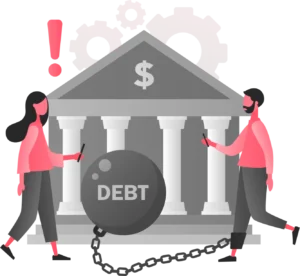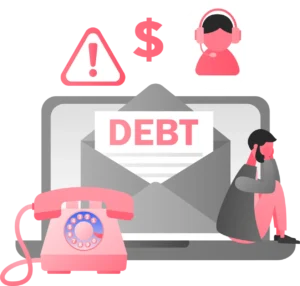The path to financial freedom often involves navigating debt. Among the various strategies available, the debt snowball method has gained prominence for its psychological and strategic benefits.
This approach, popularized by personal finance expert Dave Ramsey, focuses on paying off debt in ascending order of amount, starting with the smallest and working your way up. Understanding the debt snowball method and integrating expert insights and practical advice empowers you to take control of your financial life and reach your goals.
Understanding the debt snowball method

The debt snowball method is a debt reduction strategy designed to create positive psychological feedback through small, early victories. Here's how it breaks down:
- List your debts: List all your debts from the smallest balance to the largest, excluding your mortgage.
- Focus on minimum payments: Ensure you make the minimum payments on all your debts except the smallest.
- Extra money on the smallest debt: Allocate any extra money you have to the smallest debt until it's completely paid off.
- Roll over the payments: Once the smallest debt is paid, use the money you were paying on that debt plus any extra funds to pay off the next smallest debt.
- Repeat until debt-free: Roll over payments to the next smallest debt until all your debts are paid off.
This method can be incredibly motivating, given the psychological boost you get from seeing progress quickly.
Advertisements
The advantages of the debt snowball method
There are various advantages to implementing this debt repayment strategy, including the following:
- Psychological wins: Early payoff of smaller debts provides tangible proof of progress.
- Simplified financial management: Concentrating on one debt at a time simplifies budgeting and payment strategies.
- Behavioural change: Encourages financial discipline and budgeting habits by focusing on consistent debt repayment.
Comparing debt snowball and avalanche methods
To provide a clearer picture, let's compare the debt snowball method with its counterpart, the debt avalanche method:
| Strategy | Focus | Pros | Cons |
| Debt snowball | Smallest balances first | Quick wins boost motivation | Potentially higher interest paid over time |
| Debt avalanche | Highest interest rates first | Saves money on interest charges | May take longer to see progress |
Advertisements
Implementing the Debt Snowball Method
Implementing the debt snowball method requires discipline and a clear plan. Here's a step-by-step guide:
- Evaluate your debts: List all your nonmortgage debts from smallest to largest balance.
- Determine your budget: Assess your monthly income and expenses to find extra money for debt repayment.
- Extra payments: Direct additional funds to your smallest debt while maintaining minimum payments on others.
- Track your progress: Record each debt paid off and the remaining amount.
- Celebrate milestones: Acknowledge each debt you eliminate to maintain motivation.
Tips for maximizing the debt snowball method
You must cut unnecessary expenses wherever possible. Reduce spending on non-essentials to free up more money for debt repayment. Consider side gigs or overtime to generate extra funds. Increasing your income means more money to pay down debt. Also, use any windfalls wisely. Apply unexpected income, like tax refunds, directly to your debt.
Detailed tailoring of the debt snowball to your financial situation

Everyone’s financial journey is unique, marked by different types of debt, income levels, and personal challenges. Customizing the debt snowball method to align with your specific needs can expedite your path to debt freedom and ensure the journey is sustainable.
Assessing debts and income
Perform a thorough assessment of your debts and income. You must understand your total debt load, including credit cards, personal loans, car loans, and other obligations, against your monthly income.
Creating a strategic repayment plan
Based on this assessment, create a repayment plan that prioritizes debts by balance and considers interest rates and emotional impact. While the traditional debt snowball method suggests focusing solely on balances, being flexible to include high-interest debts earlier can save money in the long run.
Balancing emotional wins and financial efficiency
For many, the debt snowball method's appeal lies in its psychological boosts. These emotional wins can be balanced with the financial efficiency of paying off high-interest debts by occasionally deviating from the smallest to the largest balance rule, especially if two debts are similar.
Advertisements
Advanced strategies for accelerating debt repayment
Increasing your income through side jobs or freelance work can provide extra funds to throw at your debt, speeding up the snowball effect.
Creditpicks
Tweet
Beyond the basic framework of the debt snowball method, several strategies can accelerate your debt repayment journey:
- Debt consolidation loans: For those with high-interest credit card debt, a debt consolidation loan with a lower interest rate can reduce monthly payments and the total interest paid over time.
- Balance transfer credit cards: Transferring high-interest credit card debt to a balance transfer credit card offering a 0% APR introductory period can provide a temporary reprieve from interest charges, allowing more of your payment to go towards the principal balance.
- Side hustles and additional income: Increasing your income through side jobs or freelance work can provide extra funds to throw at your debt, speeding up the snowball effect.
- Budget optimization: Scrutinizing your monthly budget to cut non-essential expenses frees up more money for debt repayment. This might include dining out less, reducing entertainment expenses, or cancelling unused subscriptions.
Psychological aspects and support systems
Debt freedom is not just a financial challenge but a psychological one. The success of the debt snowball method relies heavily on maintaining motivation and a positive mindset.
- Celebrating milestones: Acknowledge and celebrate each debt you pay off. These milestones are significant achievements in your debt-free journey.
- Support systems: Share your goals with friends or family who can offer encouragement. Additionally, consider joining online forums or communities focused on debt repayment for advice and moral support.
- Maintaining perspective: Keep in mind that setbacks can happen. What's important is persistence and the willingness to adjust your strategy as needed.
Financial discipline and resiliency
Implementing the debt snowball method effectively requires a blend of strategic financial planning and psychological resilience. By customizing the method to your personal financial situation, leveraging additional strategies to accelerate debt repayment, and maintaining a supportive environment, you can confidently pursue the path to financial freedom with confidence and clarity. One book we recommend is Debt-Free Forever: Take Control Of Your Money And Your Life by Gail Vaz-Oxlade. There is great practical advice and actionable steps to eliminate their debt and achieve financial freedom. Vaz-Oxlade emphasizes the importance of taking control of one’s finances, making informed decisions, and developing a disciplined approach to money management.
Creditpicks is a leader in strategies that enhance your financial well-being. Whether you need a debt consolidation loan, a balance transfer credit card, or advice on the best investing platform, our researched and expert knowledge will equip you to live your best financial life. Sign up for our browser notifications for regular articles and offers exclusive to our site.
Advertisements




